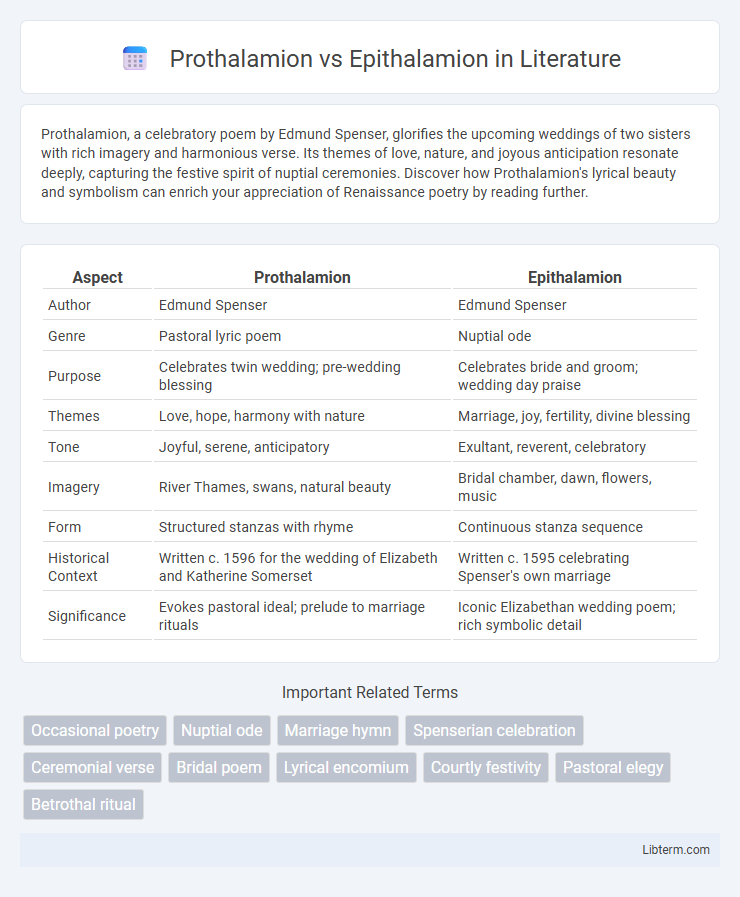Prothalamion, a celebratory poem by Edmund Spenser, glorifies the upcoming weddings of two sisters with rich imagery and harmonious verse. Its themes of love, nature, and joyous anticipation resonate deeply, capturing the festive spirit of nuptial ceremonies. Discover how Prothalamion's lyrical beauty and symbolism can enrich your appreciation of Renaissance poetry by reading further.
Table of Comparison
| Aspect | Prothalamion | Epithalamion |
|---|---|---|
| Author | Edmund Spenser | Edmund Spenser |
| Genre | Pastoral lyric poem | Nuptial ode |
| Purpose | Celebrates twin wedding; pre-wedding blessing | Celebrates bride and groom; wedding day praise |
| Themes | Love, hope, harmony with nature | Marriage, joy, fertility, divine blessing |
| Tone | Joyful, serene, anticipatory | Exultant, reverent, celebratory |
| Imagery | River Thames, swans, natural beauty | Bridal chamber, dawn, flowers, music |
| Form | Structured stanzas with rhyme | Continuous stanza sequence |
| Historical Context | Written c. 1596 for the wedding of Elizabeth and Katherine Somerset | Written c. 1595 celebrating Spenser's own marriage |
| Significance | Evokes pastoral ideal; prelude to marriage rituals | Iconic Elizabethan wedding poem; rich symbolic detail |
Introduction to Prothalamion and Epithalamion
Prothalamion and Epithalamion are distinct types of celebratory poems with roots in Renaissance literature, primarily written by Edmund Spenser. Prothalamion serves as a "prologue" wedding song, celebrating the upcoming nuptials of two brides, focusing on anticipation and joy before the wedding day. Epithalamion, by contrast, is composed as a lyrical ode sung at the bride's chamber on her wedding night, emphasizing blessings, fertility, and the sanctity of marriage.
Historical Background and Authors
Prothalamion, written by Edmund Spenser in 1596, is a celebratory poem for the twin weddings of the Earl of Worcester's daughters, showcasing early Elizabethan themes of love and harmony. Epithalamion, also by Spenser, composed in 1595, serves as a nuptial ode marking his own marriage, blending Renaissance ideals of matrimony with classical influences. Both poems reflect the Elizabethan era's literary fascination with wedding celebrations, but Prothalamion emphasizes communal joy while Epithalamion is intensely personal and ritualistic in tone.
Definition of Prothalamion
Prothalamion is a poetic form composed as a bridal song celebrating a forthcoming marriage, often honoring two brides simultaneously, while Epithalamion is a classical wedding song sung to celebrate the bride on her wedding day. Prothalamion, derived from Greek roots meaning "before the wedding," highlights anticipation and joy prior to the nuptials. This genre was famously exemplified by Edmund Spenser, who crafted a Prothalamion to honor the double marriage of Elizabeth and Katherine Somerset.
Definition of Epithalamion
Epithalamion is a traditional poem or song written specifically to celebrate a wedding or the bride on her way to the marital chamber. Unlike Prothalamion, which honors a double marriage or nuptials before the wedding, Epithalamion is composed to praise the bride and express hopes for a happy and fertile union. The genre originated in ancient Greece and has been notably developed by poets like Edmund Spenser.
Thematic Differences
Prothalamion celebrates the joyous anticipation of marriage by depicting a double wedding and emphasizing themes of youth, beauty, and hope. Epithalamion centers on the wedding night itself, highlighting fertility, union, and the consummation of love in a sacred, ritualistic context. The thematic difference lies in Prothalamion's forward-looking optimism versus Epithalamion's focus on marital fulfillment and procreation.
Structural and Stylistic Contrasts
Prothalamion employs a lyrical and celebratory structure featuring stanzas with refrains that evoke a joyful anticipation for marriage, while Epithalamion is characterized by a complex, hour-by-hour progression reflecting the wedding day's temporal flow. Stylistically, Prothalamion uses repetitive and ritualistic language to emphasize communal celebration, contrasting with Epithalamion's vivid imagery and intense emotional depth that convey personal passion and intimate experience. The formal constraints of Epithalamion, including its meticulously measured stanzas, highlight the solemnity and grandeur of the wedding night, whereas Prothalamion's freer, musical composition fosters a light, festive atmosphere.
Symbolism and Imagery in Prothalamion
Prothalamion employs vivid natural imagery, such as twin swans on the river, symbolizing purity, love, and the union of the bridal couples, creating an atmosphere of serenity and celebration. The recurrent motifs of water and flowers evoke fertility and renewal, reinforcing the themes of marriage and harmony. This rich symbolism contrasts with the more solemn and prophetic tone of Epithalamion, emphasizing joy and the beginnings of marital life.
Symbolism and Imagery in Epithalamion
Epithalamion by Edmund Spenser employs rich symbolism and vivid imagery to celebrate the sanctity of marriage, portraying the bride as a radiant embodiment of purity and joy. Symbolic references to nature, such as blossoming flowers and circling birds, underscore themes of fertility, renewal, and eternal love. The poem's intricate use of light and sound imagery enhances the joyful atmosphere, reflecting the harmonious union between two souls.
Cultural and Literary Significance
Prothalamion, written by Edmund Spenser, is a nuptial poem celebrating the double wedding of noble siblings, reflecting Renaissance ideals of harmony and social order through elaborate nature imagery and classical allusions. Epithalamion, also by Spenser, serves as a wedding hymn meant to honor the bride and groom on their wedding day, emphasizing themes of love, fertility, and divine blessing with rhythmic structure and rich symbolism. Both poems hold significant cultural value in Elizabethan literature, exemplifying the ceremonial function of poetry in marriage rituals and social unity during the period.
Conclusion: Comparing Prothalamion and Epithalamion
Prothalamion and Epithalamion both celebrate nuptial themes through distinctive poetic forms, with Prothalamion traditionally marking the eve of marriage and Epithalamion commemorating the wedding day. The contrast lies in their temporal focus and tone, where Prothalamion conveys anticipatory joy and Epithalamion expresses consummated union and marital bliss. Together, they encapsulate the poetic tradition of marriage, intertwining themes of love, celebration, and social ritual within Renaissance literature.
Prothalamion Infographic

 libterm.com
libterm.com